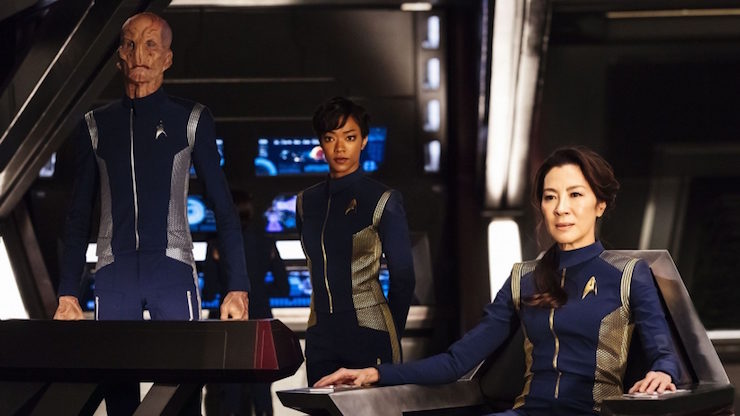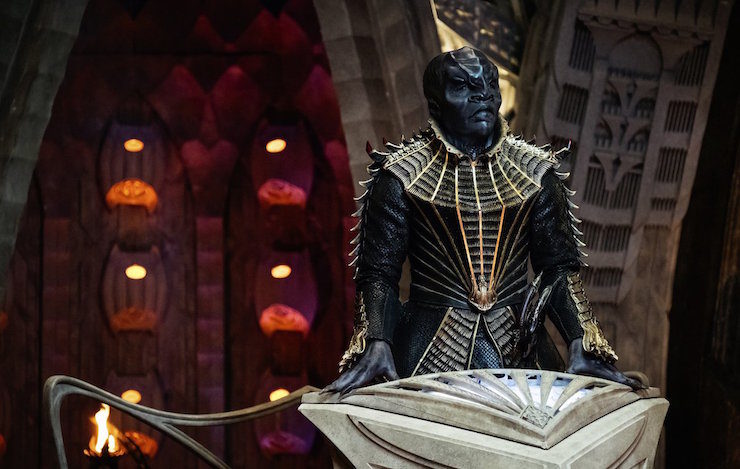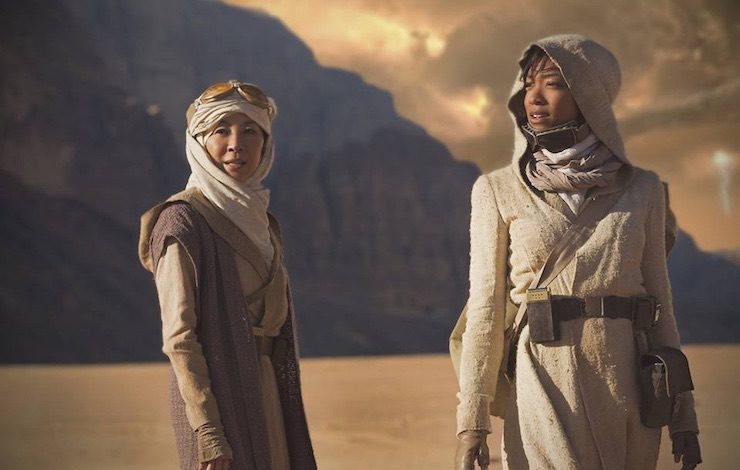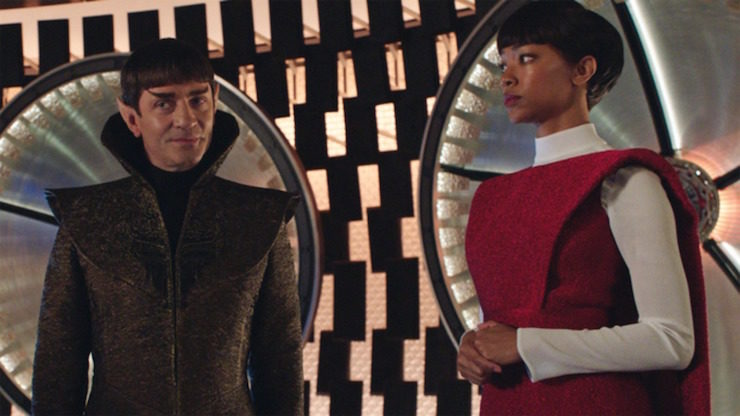Let us discuss a new Star Trek that people have to pay for instead of watching for free. One in which the Klingons have been completely redesigned, one in which the technology looks completely different from what we would expect, as do the uniforms—all without a word of explanation. One in which one of the main characters has to reconcile human and Vulcan values. And one in which the production was fraught with behind-the-scenes difficulties.
I am, of course, talking about Star Trek: The Motion Picture in 1979.
Nothing changes, and it’s amusing that there’s been so much fulminating on the Internet about things that Trek has done before. Both Enterprise and the Bad Robot movies have given us time periods before the original series that, nonetheless, have technology more advanced than what we saw on TOS. (Hell, take out the warp drive and transporter and the original Enterprise was less technologically sophisticated than a modern Manhattan office building.) The Klingons have been redesigned more times than I can count, starting with the complete revamping of them in The Motion Picture, and the discrepancy wasn’t even acknowledged for another 17 years (in DS9’s “Trials and Tribble-ations” in 1996), and not actually explained for another nine (in Enterprise’s “Affliction”/”Divergence” in 2005).
But this is not the first time Star Trek has switched to a pay model rather than a free one, since everyone had to shell out their $2.50 for a movie ticket to see The Motion Picture 38 years ago. This is not the first time they’ve gone backwards rather than forwards in the timeline. This is not the first time they’ve gone with a hip, new way of watching television, as nobody was doing first-run syndicated dramas in 1987, but The Next Generation paved the way for a renaissance in the 1980s and 1990s of such shows, which only petered out due to the growth of the FOX network, the rise of the WB and UPN (later merged into the CW), and tons of cable stations starting to produce their own original programming rather than just reruns of other people’s. For all those complaining about CBS All Access, that service was going to happen no matter what, and it’s a sign of CBS’s confidence in Star Trek that they are using it to try to get people to subscribe to it.
(I’ve also been amused listening to people complain about continuity violations that aren’t. Complaints, for example, about other ships having the delta as their symbol, even though other ships had different symbols in TOS—except in the first season, all Starfleet personnel had the delta, cf. “Court Martial” and “The Menagerie.” The notion of other ships with different insignia wasn’t seen until “The Doomsday Machine,” and it’s something that was abandoned by the time the movies came around. Also Klingons don’t have cloaking technology—except, of course, the Klingon Empire doesn’t have it here, either, only the one ship does, and it’s unique. How could Sarek have a human ward and us not know about it, never mind that Spock wasn’t actually on speaking terms with his father when this takes place and it’s not like Spock ever talked about his family ever unless forced into it, cf. “Amok Time” and “Journey to Babel.” And of course the use of holography, which hasn’t been seen in prior Trek productions purely for budget reasons—they had a bit of it in first-season TNG, but had to drop it because the effects were too expensive. It was Gene Roddenberry himself who provided a good explanation for this back when the Klingons suddenly became bumpy-headed in 1979: they always looked like that, we just lacked the budget to show them looking that way. Ditto the technology…)
Enough of that, though, as all of this is ultimately irrelevant in comparison to the much more important matter: Is Discovery any good?
Yes. Yes, it is. It’s not perfect and has a lot of head-scratchers, but they’re obviously telling a single season-long story here involving the Klingons, and I’m definitely along for the ride.
Having said that, let’s get a few problems out of the way. First of all, I love that they’re using Marc Okrand’s Klingon language. The movies and early TNG used the Klingonese Okrand created for The Search for Spock pretty religiously, but with each spinoff, they moved further and further away, mostly just pulling harsh-sounding words out of their asses.
But just because you’re having Klingons speak their own language among each other doesn’t free you from the obligation of making it sound conversational. Chris Obi does the best he can as T’Kuvma, the person trying to unite the Klingon Empire in a war against the Federation, but his delivery is so labored, his speeches so long, that it grinds the episode to a halt every time he talks. Obi (who is excellent as Anubis on the other current series with Bryan Fuller’s name on it, American Gods) really would have been served better by speaking a language he’s actually comfortable in, especially since the Klingon makeup remains death on facial expressions, and the power of his voice is muted by forcing him to wrap his tongue around a made-up language.
The dialogue in these first two episodes is awkward in spots. Georgiou and Burnham’s landing party conversations at the opening have been blessed a little too aggressively with the exposition fairy, and Connor’s flight-attendant riff right before Burnham goes to check out the beacon isn’t nearly as funny as the script wants it to be. In general, the scripts are a bit of a mess tonally, no doubt a result of all the different hands on it, all of whom have “executive producer” as their title.
Also, must everything be underlit? I thought we got over this with Battlestar Galactica. The bridge of the Shenzhou is way way too dark…
Having said that, there’s some excellent stuff here. The relationship between Georgiou and Burnham is a strong one. It’s rare enough to see two women of color in this kind of mentor-mentee relationship, and I’m grumpy that we won’t get to see more of it except maybe in flashbacks. As it is, seeing a TV show not only pass the Bechdel Test, but also take the extra-credit portions of it, is a welcome thing, and exactly the sort of barrier Trek should be breaking. And also why I’m disappointed that, based on the previews, Burnham is going to wind up teamed up with a white guy, with all due respect to Jason Isaacs.
Still, the Georgiou-Burnham relationship is a good one, an interesting variation on the human/Vulcan dynamic that was such a pivotal part of the original series, as well as Voyager and Enterprise. Sonequa Martin-Green’s portrayal is delightfully nuanced, showing the Vulcan training, but still giving us the human emotionalism. She tries to use logic to convince Georgiou to fire on the Klingons, but Georgiou (rightfully) stands her ground. Now it’s possible—likely, even—that the massacre we get in “Battle at the Binary Stars” would have happened regardless. But the Federation is a nation of peace who will only attack when attacked first. Yes, the Klingons will respect a show of force. However, it’s obvious that T’Kuvma was going to attack no matter what.
(By the way, if you want to see more of the Georgiou-Burnham dynamic, pick up David Mack’s Discovery novel Desperate Hours, which goes on sale tomorrow, the 26th of September, and takes place during Burnham’s early days serving on the Shenzhou.)
As someone who has written a lot about Klingon history (and made some of it up, too), I’m fascinated by the political dynamics of the empire here. The reference to not seeing a Klingon in person for a hundred years indicates that the Klingons have mostly stayed out of galactic affairs since the last season of Enterprise (when the Augment virus led to some Klingons becoming smooth-headed, thus explaining the ones we saw on TOS), with occasional exceptions like the Battle of Donatu V (first referenced in “The Trouble with Tribbles,” and also mentioned here) and the attack that killed Burnham’s family. Internecine fighting among Klingon noble Houses is a story as old as the hills, but it’s one that fits with the Klingon history we have seen unfold on screen both chronologically before and after this storyline.
What I especially love is that we see the clash of cultures. Humans unwilling to fire first, but willing to fight back if attacked. Klingons who view “we come in peace” as an insult and a lie, for whom battle is all important, and to sue for peace the way of cowards and fools. Vulcans who let logic and science dictate their actions, and who view emotionalism as something to be overcome. That clash is what leads to a state of war at the end of “Battle at the Binary Stars,” as Georgiou’s human peace offering, Burnham’s Vulcan approach of firing first based on past evidence, and T’Kuvma’s personal mission of redemption-through-war all crash into each other and explode.
It’s obvious from the previews that finding their way back to peace, finding a way to reconcile these disastrously divergent POVs, will be the macrocosmic arc of the season, with Burnham’s redemption being the microcosmic one. I gotta say, it’s nice to see a Starfleet officer commit an act of mutiny and actually suffer for it. I also was highly amused by Burnham whipping out that old Trek standby of out-logic-ing a computer, in this case escaping the damaged brig before the force field died, only unlike when Kirk did it, Burnham’s logic actually made sense…
These two episodes set things up nicely. The acting is uniformly strong. I’ve been a fan of Martin-Green since she appeared as an obnoxious boarding school student on a 2008 Law & Order: Criminal Intent episode, and she was also in the tragically short-lived NYC 22, and it’s good to see her take the lead here. I particularly like the flashbacks to her arrival on the Shenzhou, where she’s so very Vulcan (it reminds one favorably of Michael Dorn playing Worf as so very Klingon). Nobody ever went wrong casting Michelle Yeoh in anything—and hey, she even got a hand-to-hand combat scene!—as she imbues Georgiou with compassion and wit and effortless grace and wisdom. (Isaacs, who hasn’t been seen yet, has a lot to live up to following in her footsteps.) James Frain is excellent casting as Sarek (helluva lot better than Ben Cross, that’s for sure). And Doug Jones’s Lieutenant Saru is a delight, his earnestly snide commentary providing a nice dose of salt on the proceedings.
Doing this as a prequel may have been a mistake. Besides the technological issues, there’s also the fact that we know this war can’t go on too long because the Klingons had a cease-fire in place with the Federation in the early days of the original series—we know this because it was broken in “Errand of Mercy,” and another war would have started, but for the Organians shaking their fists and telling those kids to get off their lawn. Knowing the outcome is frustrating, and there’s really nothing in this story that requires that it take place in the 23rd century—the same basic story could have been told by doing what The Next Generation did so successfully three decades ago and jump the timeline by 80 years after the end of the Dominion War, Data’s death, and Voyager’s return home. The only thing we’d lose is Sarek as Burnham’s mentor, but so far there’s nothing about that character that requires it to be Sarek except for the nerdy continuity hit, and we’ve got plenty of those already.
Still, a prequel is what we got, and there’s a lot of story meat here: the war-vs.-peace dynamic, the redemption of Michael Burnham, the Klingon politics, and more. Can’t wait to see what happens next. Keep an eye on this space each week for reviews of each episode as CBS All Access releases them.
Keith R.A. DeCandido has written a metric buttload of Star Trek fiction, including 16 novels, 13 novellas, six comic books, seven short stories, and a coffee-table book, the latter being The Klingon Art of War. He’s also written about Star Trek for Entertainment Weekly, Star Trek: The Official Magazine, Outside in Makes It So, New Worlds and New Civilizations, and this very web site, including detailed rewatches of the original series, The Next Generation, and Deep Space Nine. His latest work includes the Orphan Black reference tome Classified Clone Report, the omnibus Marvel’s Thor: Tales of Asgard, collecting all three books in his trilogy starring Thor, Sif, and the Warriors Three, and short stories in the anthologies Nights of the Living Dead (co-edited by the late George Romero), Aliens: Bug Hunt, The Best of Bad-Ass Faeries, TV Gods: Summer Programming, Stargate SG-1/Atlantis: Homeworlds, and Baker Street Irregulars.













